Towards Sustainable Food Security through Regional Grain Supply and Demand Analysis in China
Abstract
1. Introduction
2. Materials and Methods
2.1. Data Sources
2.2. Methods
3. Results
3.1. Enlarged Regional Disparities Based on Variations in Grain Supply–Demand Conditions
3.2. Dual Effects from the Population and Grain Output on Regional Grain Insecurity
3.3. Uneven Distribution of Cultivated Land under Four Types of Grain Insecurity
4. Discussion
4.1. Contributions and Uncertainties
4.2. Enlarged Disparities among Producing, Consuming, and Balanced Areas
4.3. Sustainable Approaches to Regional Grain Security
5. Conclusions
Author Contributions
Funding
Institutional Review Board Statement
Informed Consent Statement
Data Availability Statement
Conflicts of Interest
References
- Ercin, E.; Veldkamp, T.I.E.; Hunink, J. Cross-border climate vulnerabilities of the European Union to drought. Nat. Commun. 2021, 12, 3322. [Google Scholar] [CrossRef] [PubMed]
- Bentley, A.R.; Donovan, J.; Sonder, K.; Baudron, F.; Lewis, J.M.; Voss, R.; Rutsaert, P.; Poole, N.; Kamoun, S.; Saunders, D.G.O.; et al. Near- to long-term measures to stabilize global wheat supplies and food security. Nat. Food 2022, 3, 483–486. [Google Scholar] [CrossRef]
- Leroy, J.L.; Ruel, M.; Frongillo, E.A.; Harris, J.; Ballard, T.J. Measuring the Food Access Dimension of Food Security: A Critical Review and Mapping of Indicators. Food Nutr. Bull. 2015, 36, 167–195. [Google Scholar] [CrossRef] [PubMed]
- FAO. An Introduction to the Basic Concepts of Food Security; FAO: Rome, Italy, 2008. [Google Scholar]
- Wheeler, T.; Von Braun, J. Climate Change Impacts on Global Food Security. Science 2013, 341, 508–511. [Google Scholar] [CrossRef]
- Xu, J.; Ding, Y. Research on Early Warning of Food Security Using a System Dynamics Model: Evidence from Jiangsu Province in China. J. Food Sci. 2015, 80, R1–R9. [Google Scholar] [CrossRef]
- Wang, J.; Zhang, Z.; Liu, Y. Spatial shifts in grain production increases in China and implications for food security. Land Use Policy 2018, 74, 204–213. [Google Scholar] [CrossRef]
- Pretty, J.; Benton, T.G.; Bharucha, Z.P.; Dicks, L.V.; Flora, C.B.; Godfray, H.C.J.; Goulson, D.; Hartley, S.; Lampkin, S.; Morris, C.; et al. Global assessment of agricultural system redesign for sustainable intensification. Nat. Sustain. 2018, 1, 441–446. [Google Scholar] [CrossRef]
- Zhang, J.; Zhang, F.; Zhang, D.; He, D.; Zhang, L.; Wu, C.; Kong, X. The grain potential of cultivated lands in Mainland China in 2004. Land Use Policy 2009, 26, 68–76. [Google Scholar] [CrossRef]
- Anderson, K.; Strutt, A. Food security policy options for China: Lessons from other countries. Food Policy 2014, 49, 50–58. [Google Scholar] [CrossRef]
- Springmann, M.; Clark, M.; Mason-D’Croz, D.; Wiebe, K.; Bodirsky, B.L.; Lassaletta, L.; de Vries, W.; Vermeulen, S.J.; Herrero, M.; Carlson, H.M.; et al. Options for keeping the food system within environmental limits. Nature 2018, 562, 519–525. [Google Scholar] [CrossRef]
- Verburg, P.H.; Chen, Y.; Veldkamp, T.A. Spatial explorations of land use change and grain production in China. Agric. Ecosyst. Environ. 2000, 82, 333–354. [Google Scholar] [CrossRef]
- Liu, Y.S.; Wang, J.Y.; Guo, F.Y. The spatial-temporal changes of grain production and arable land in China. Sci. Agric. Sin. 2009, 42, 4269–4274. [Google Scholar]
- Fan, M.; Shen, J.; Yuan, L.; Jiang, R.; Chen, X.; Davies, W.J.; Zhang, F. Improving crop productivity and resource use efficiency to ensure food security and environmental quality in China. J. Exp. Bot. 2012, 63, 13–24. [Google Scholar] [CrossRef]
- Yu, X.; Sun, J.; Sun, S.; Yang, F.; Lu, Y.; Wang, Y.; Wu, F.; Liu, P. A comprehensive analysis of regional grain production characteristics in China from the scale and efficiency perspectives. J. Clean. Prod. 2019, 212, 610–621. [Google Scholar] [CrossRef]
- Hu, T.; Ju, Z.; Zhou, W. Regional pattern of grain supply and demand in China. Acta Geogr. Sin. 2016, 71, 1372–1383. [Google Scholar]
- Wu, J.S.; Jiang, P.P.; Huang, X.L.; Peng, J.; Wang, Z. Spatial-temporal analysis of grain supply and demand in rapid urbanization regions in eastern China: A case study of Guangdong Province. J. Nat. Resour. 2013, 28, 253–265. [Google Scholar]
- Ran, D.; Zhang, Z.; Jing, Y. A Study on the Spatial–Temporal Evolution and Driving Factors of Non-Grain Production in China’s Major Grain-Producing Provinces. Int. J. Environ. Res. Public Health 2022, 19, 16630. [Google Scholar] [CrossRef]
- Deng, X.; Huang, J.; Rozelle, S.; Zhang, J.; Li, Z. Impact of urbanization on cultivated land changes in China. Land Use Policy 2015, 45, 1–7. [Google Scholar] [CrossRef]
- Hu, G.; Li, X.; Zhou, B.-B.; Ma, Q.; Meng, X.; Liu, Y.; Chen, Z.; Liu, X. How to minimize the impacts of urban expansion on farmland loss: Developing a few large or many small cities? Landsc. Ecol. 2020, 35, 2487–2499. [Google Scholar] [CrossRef]
- Lu, M. Myths and Realities of China’s Urbanization; Paulson Policy Memorandum; Paulson Institute: Chicago, IL, USA, 2015; pp. 3–4. [Google Scholar]
- Wuepper, D.; Le Clech, S.; Zilberman, D.; Mueller, N.; Finger, R. Countries influence the trade-off between crop yields and nitrogen pollution. Nat. Food 2020, 1, 713–719. [Google Scholar] [CrossRef]
- Lu, S.-s.; Liu, Y.-s.; Long, H.-l.; Huan, X.-H. Agricultural Production Structure Optimization: A Case Study of Major Grain Producing Areas, China. J. Integr. Agric. 2013, 12, 184–197. [Google Scholar] [CrossRef]
- Jiang, L.; Chen, X.; Meng, L.; Zhang, G.; Pan, Z.; An, P. Increased grain production of cultivated land by closing the existing cropping intensity gap in Southern China. Food Secur. 2021, 13, 385–398. [Google Scholar] [CrossRef]
- Song, S.; Goh, J.C.L.; Tan, H.T.W. Is food security an illusion for cities? A system dynamics approach to assess disturbance in the urban food supply chain during pandemics. Agric. Syst. 2021, 189, 103045. [Google Scholar] [CrossRef]
- Su, Y.; Li, C.; Wang, K.; Deng, J.; Shahtahmassebi, A.R.; Zhang, L.; Ao, W.; Guan, T.; Pan, Y.; Gan, M. Quantifying the spatiotemporal dynamics and multi-aspect performance of non-grain production during 2000–2015 at a fine scale. Ecol. Indic. 2019, 101, 410–419. [Google Scholar] [CrossRef]
- Huang, W.; Yu, Z. Current situations and recommendations for non-grain tendency of farmland in Anhui province. Asian Agric. Res. 2016, 8, 57. [Google Scholar]
- Albrecht, T.R.; Crootof, A.; Scott, C.A. The Water-Energy-Food Nexus: A systematic review of methods for nexus assessment. Environ. Res. Lett. 2018, 13, 43002. [Google Scholar] [CrossRef]
- Sadeghi, S.H.; Moghadam, E.S.; Delavar, M.; Zarghami, M. Application of water-energy-food nexus approach for designating optimal agricultural management pattern at a watershed scale. Agric. Water Manag. 2020, 233, 106071. [Google Scholar] [CrossRef]
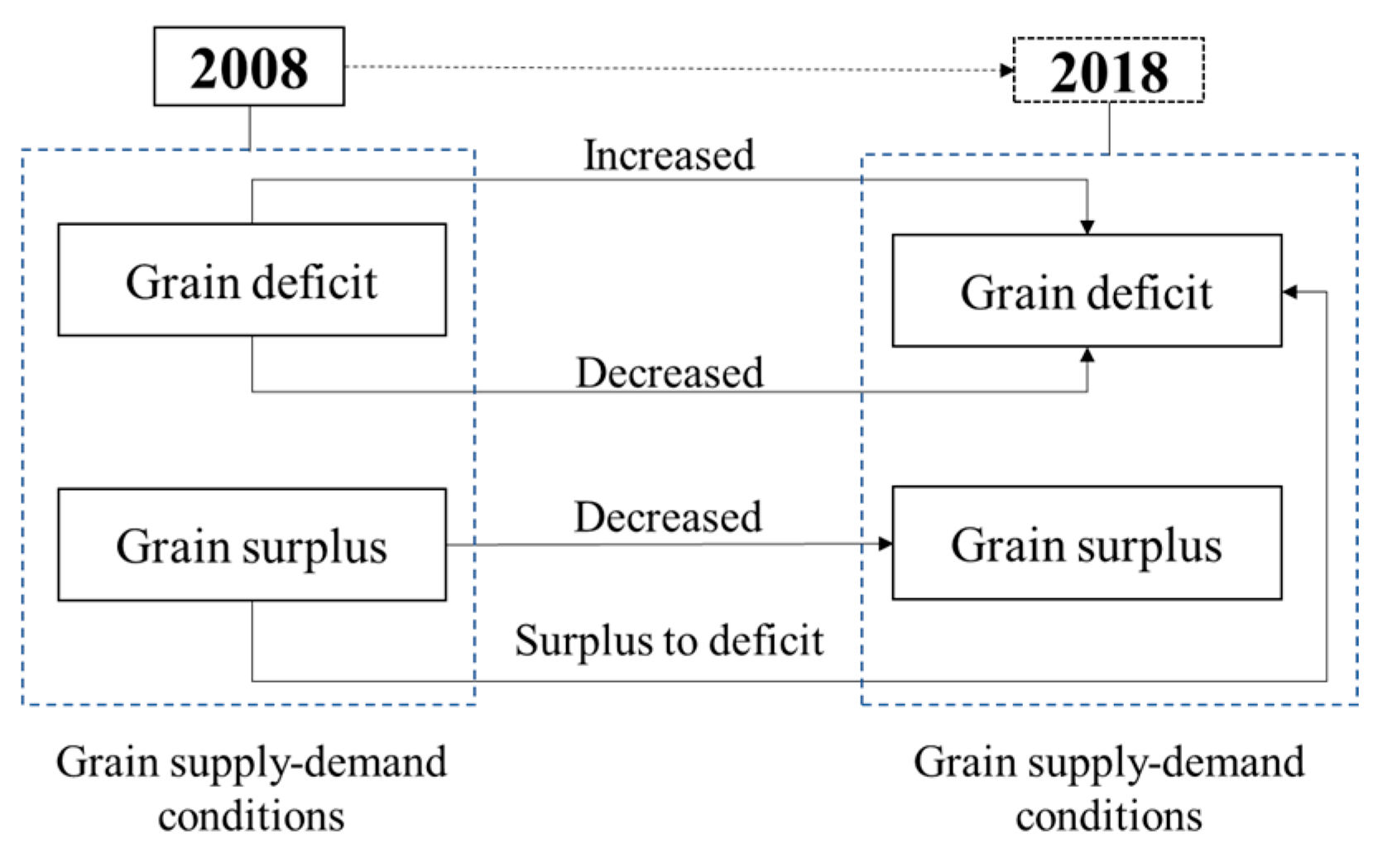
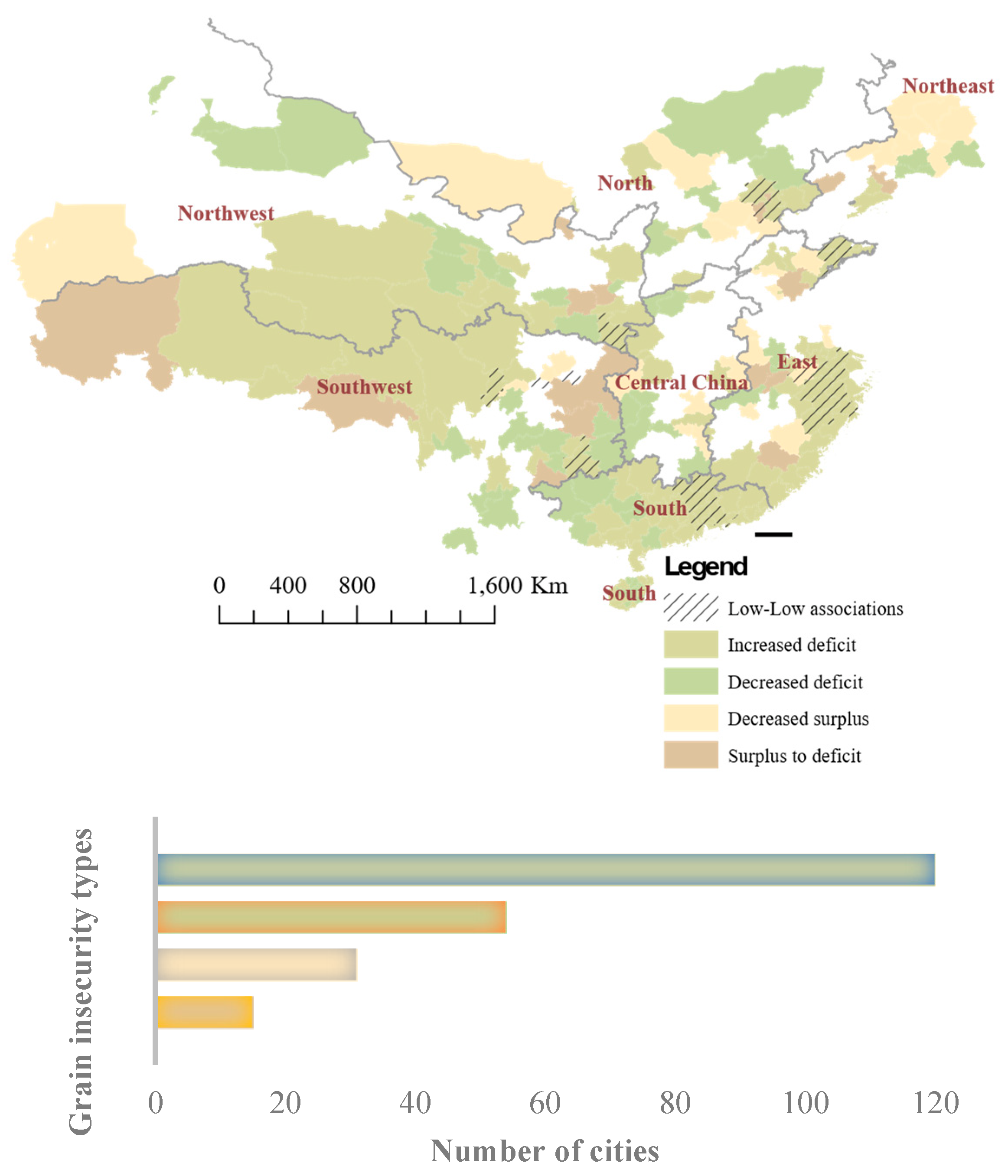
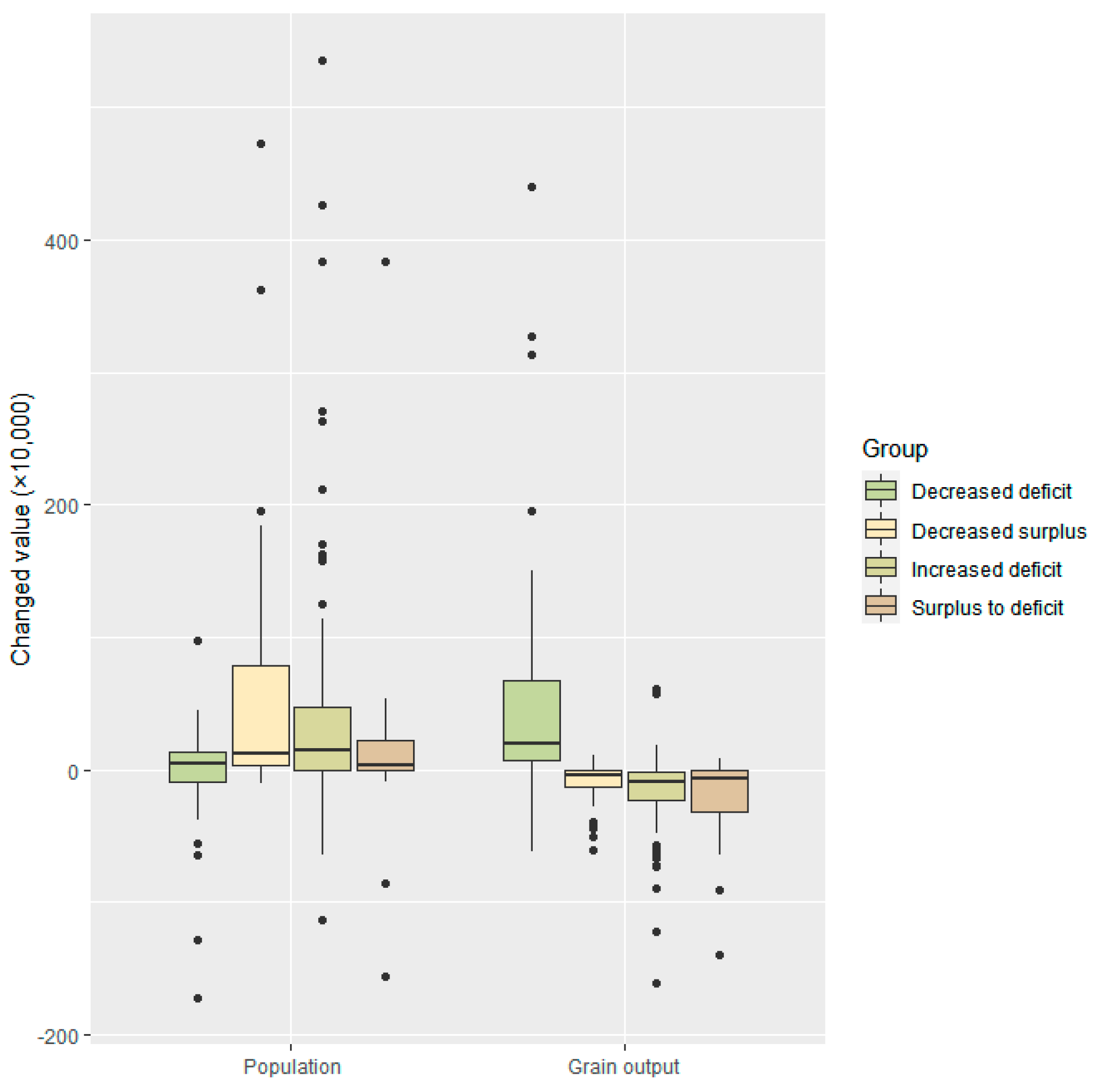
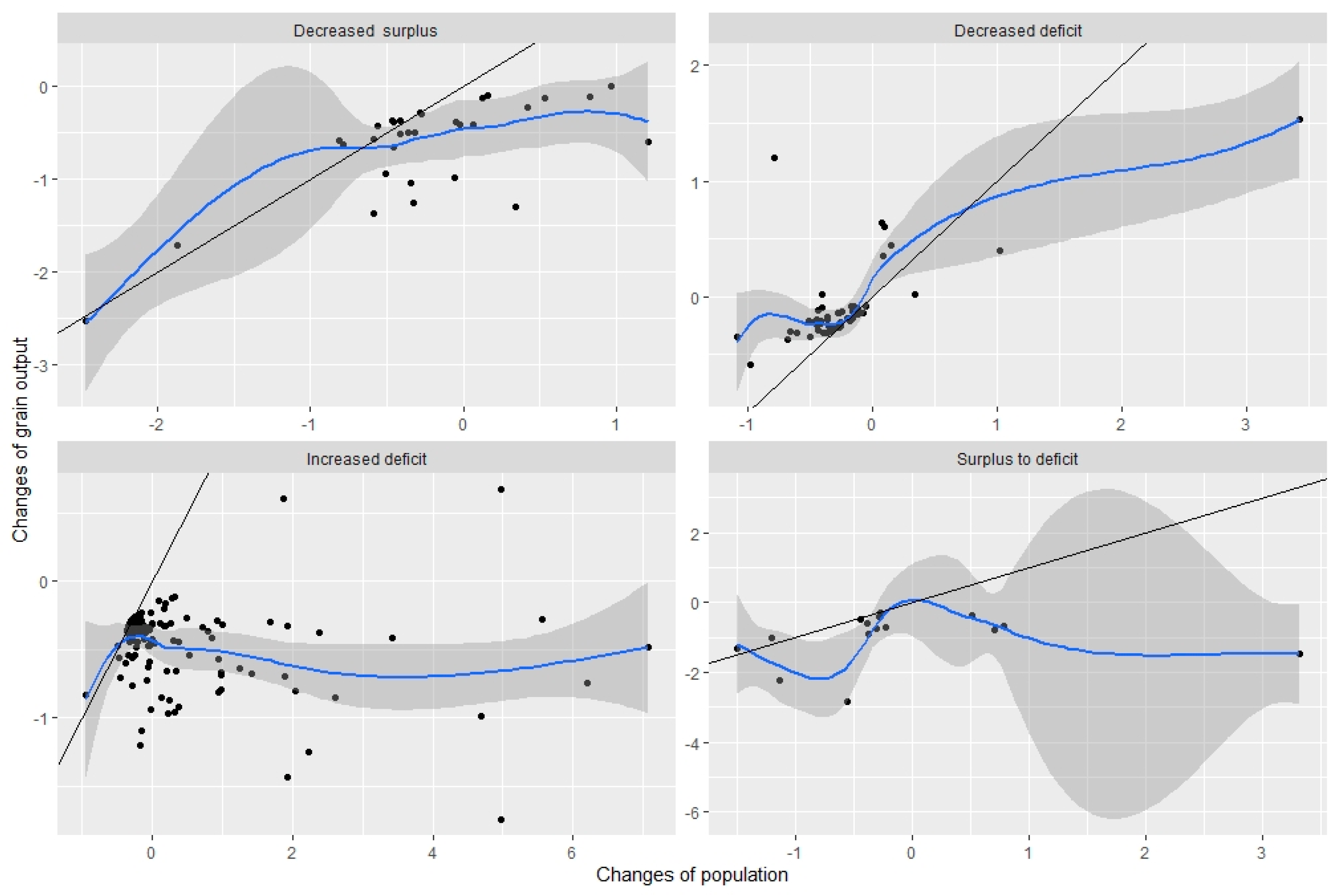
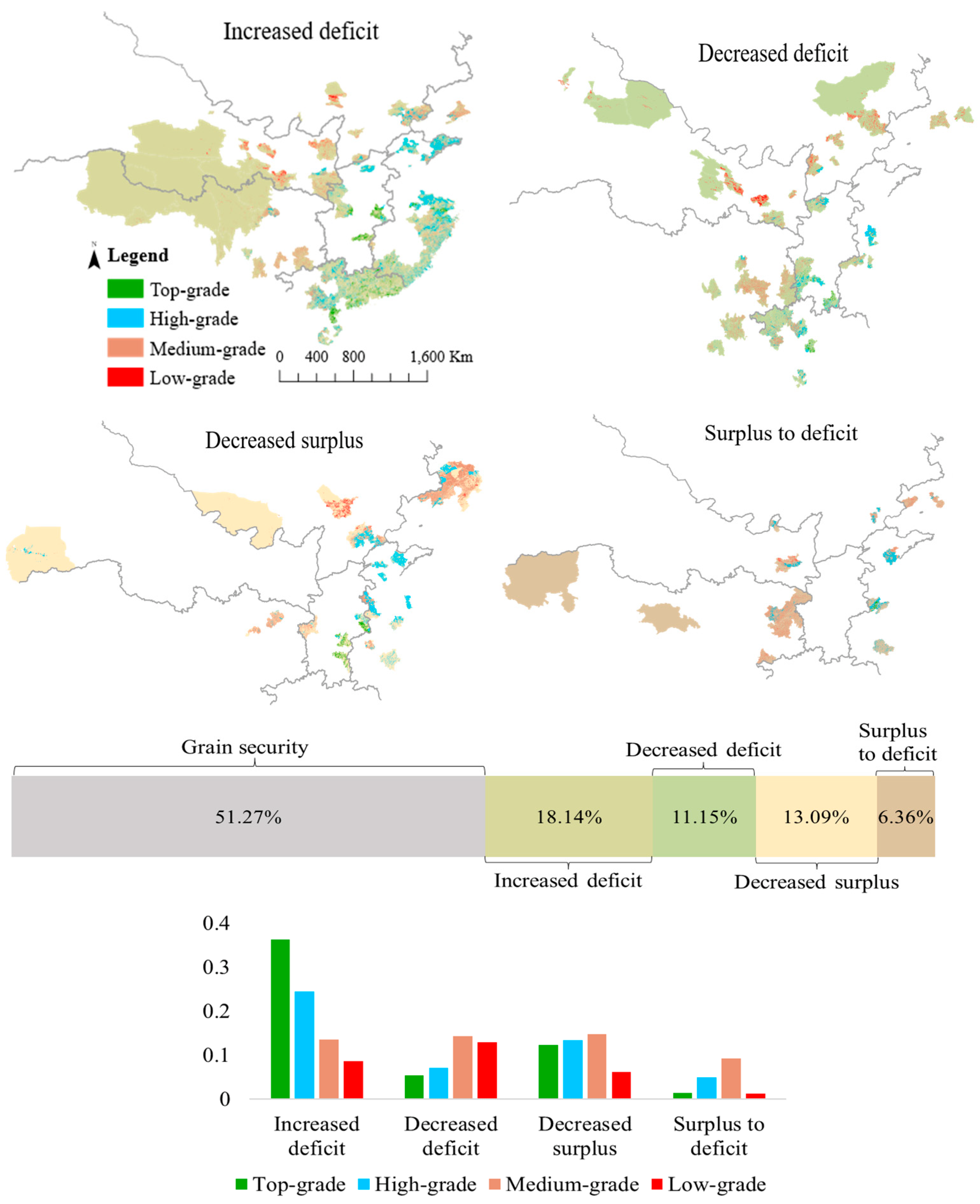

Disclaimer/Publisher’s Note: The statements, opinions and data contained in all publications are solely those of the individual author(s) and contributor(s) and not of MDPI and/or the editor(s). MDPI and/or the editor(s) disclaim responsibility for any injury to people or property resulting from any ideas, methods, instructions or products referred to in the content. |
© 2023 by the authors. Licensee MDPI, Basel, Switzerland. This article is an open access article distributed under the terms and conditions of the Creative Commons Attribution (CC BY) license (https://creativecommons.org/licenses/by/4.0/).
Share and Cite
Hu, T.; Ju, Z.; Liu, X. Towards Sustainable Food Security through Regional Grain Supply and Demand Analysis in China. Int. J. Environ. Res. Public Health 2023, 20, 3434. https://doi.org/10.3390/ijerph20043434
Hu T, Ju Z, Liu X. Towards Sustainable Food Security through Regional Grain Supply and Demand Analysis in China. International Journal of Environmental Research and Public Health. 2023; 20(4):3434. https://doi.org/10.3390/ijerph20043434
Chicago/Turabian StyleHu, Tian, Zhengshan Ju, and Xiaoyang Liu. 2023. "Towards Sustainable Food Security through Regional Grain Supply and Demand Analysis in China" International Journal of Environmental Research and Public Health 20, no. 4: 3434. https://doi.org/10.3390/ijerph20043434
APA StyleHu, T., Ju, Z., & Liu, X. (2023). Towards Sustainable Food Security through Regional Grain Supply and Demand Analysis in China. International Journal of Environmental Research and Public Health, 20(4), 3434. https://doi.org/10.3390/ijerph20043434






